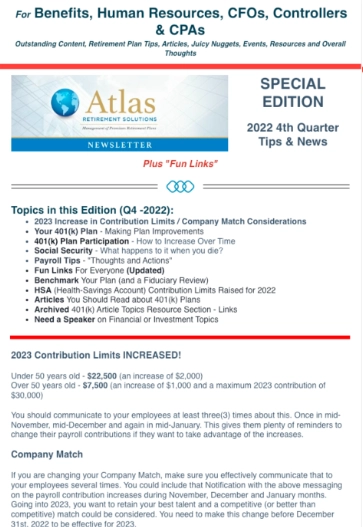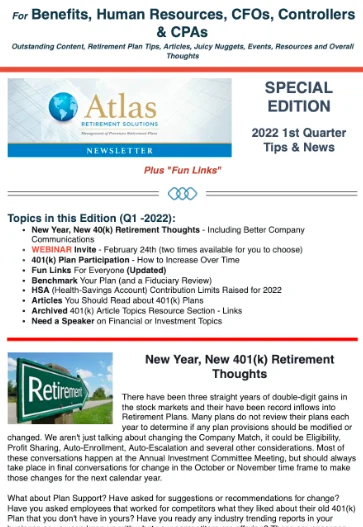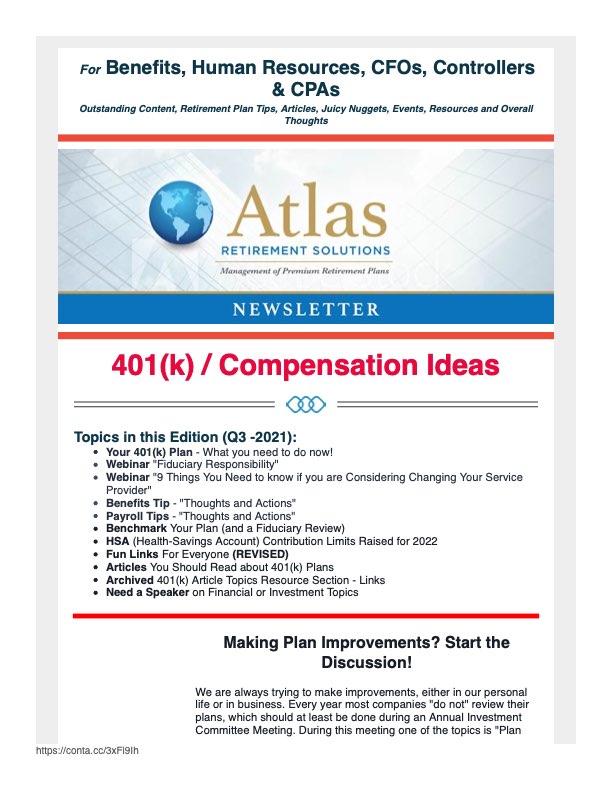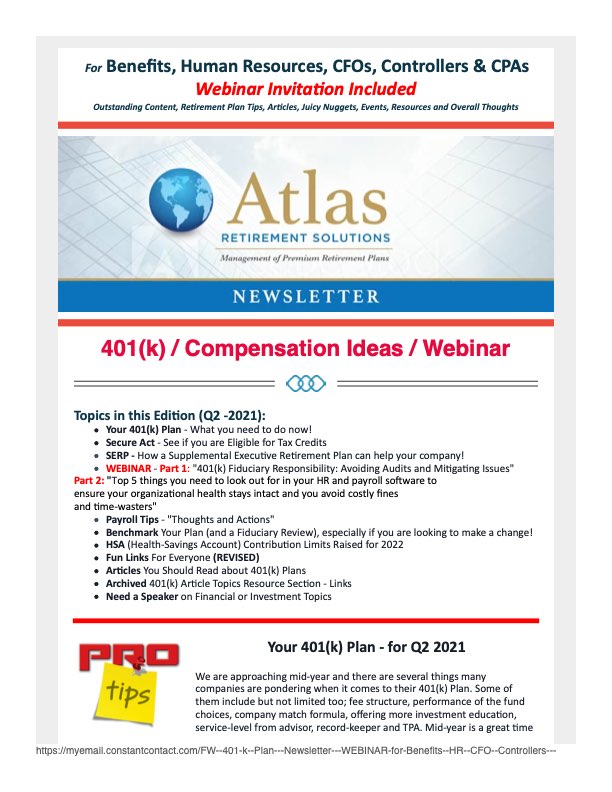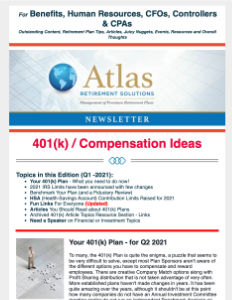Provided by Atlas 401(k) Retirement Solutions – www.Atlas401kPlans.com
2017 Year in Review
What a year! The “wealth effect” has certainly taking traction, as it was near impossible that participants didn’t make money unless they were in cash only or some Bond funds. When a market performance year like this happens, it’s tough to determine where the issues or dissatisfaction may be with your company 401(k) Plan. This is why it may be your fiduciary responsibility to perform an independent review. You should be doing this every 1-2 years anyway, as possible issues could be masked by a solid year in market returns.
While the DOL delayed the BICE Rule (Best Interest Clause Exemption again it doesn’t absolve you from your fiduciary responsibilities. It is still important that you should consider using a fiduciary for your Plan Sponsor consulting and Participant investment advice assistance. This helps alleviate your fiduciary burden. Despite the delay, the DOL will look very strongly on doing what is right for your plan and participants along with making sure fees are reasonable. The DOL will also focus on your asset lineup and their fees and performance.
Law suits were the rise in 2017 against Plan Sponsors neglecting their fiduciary responsibility or not doing enough to review the plan and make necessary improvements. Typically the attorney’s are going after the bigger fish in the pond and are targeting companies with a greater number of citations and specific types of citations against the plan. The DOL are doing the same things, but they also have an algorithm to randomly choose Plan Sponsors no matter the size of the plan or number of participants in the company. Do not assume that if you are a small company that you are flying under the radar. If there is a citation filed against your plan or your number comes up randomly, be prepared.
Lastly, its important to be “checklist-oriented” with your 401(k) Plan. Meaning, you should have a fiduciary calendar of events, keep up with your administrative duties and paperwork, benchmark your plan along with soliciting feedback from your participants. Doing these items will prepare you for any type of DOL audit and cover the majority of your responsibility towards the 401(k) Plan and audit requirements.
Participant Satisfaction
Soliciting feedback from your participants is not only easy, but will garner information that you may not have gotten otherwise. Many companies don’t do an exit interview with outgoing employees and those that do end up finding out many problem areas in the company that was not surfaced in any other way. You can use on-line survey tools to easily put together a 5-7 question survey and aggregate those results. Use this information as a line item in your Investment Committee meeting to review the results that will construct a list of improvements for the 401(k) Plan. Whether your Investment Committee meets once per year, quarterly or semi-annually, it is important to have this information documented and filed. Make sure you review the “issues” from participants. If you get several issues that are the same over time, its important you address them within a reasonable period of time. If not, that is something the DOL will frown upon.
Fiduciary Compliance
We’ve discussed some areas of Fiduciary Compliance in this document already. The BICE (Best-Interest Clause Exception) has been delayed again, but doesn’t mean that you shouldn’t insist on Fiduciary help at the Plan Sponsor and the Participant levels.
- Review your Fiduciary calendar for 2018.
- Update your Fiduciary file of documents. Upload to the cloud to backup and share.
- Participant Satisfaction Survey.
- Schedule your Investment Committee meeting(s) early.
- Book at least annual, preferably at least semi-annual on-site investment advisor availability for the plan participants. Put memo of those announcements in your Fiduciary File.
Advanced Benchmarking
We beat the drum on this every year. If we (Atlas) have not worked with you, then a Plan Review and Benchmark Analysis creates a “baseline” of where you are and how you compare to your peers and DOL standards. Get an independent review as this helps satisfy one of your fiduciary responsibilities that you checked with an independent source on your fee structure, how reasonable they are and if your asset lineup is within reasonable fee guidelines and expected performance. Contact Atlas to schedule your review if you have not completed one within the last 12-24 months.
Discrimination Testing
Start in the October/November timeframe to “pre-test” Discrimination Testing. You don’t want any surprises after the year is done that you didn’t pass one or more tests and then have to do claw backs in participant contributions or find out the Plan Sponsor match is significantly more than expected. By testing early, you can prepare for several options available to you.
Here is some information on Discrimination Testing from ERISA that may help:
The Employee Retirement Income Security Act (ERISA) requires several tests each year to prove 401(k) plans do not discriminate in favor of employees with higher incomes. For some of the tests, employees are divided between non-highly compensated employees (NHCEs) and highly compensated employees (HCEs).
Plan sponsors must test traditional 401(k) plans each year to ensure that the contributions made by and for rank-and-file employees (nonhighly compensated employees (NHCE)) are proportional to contributions made for owners and managers (highly compensated employees (HCE)). As the NHCEs save more for retirement, the rules allow HCEs to defer more. These nondiscrimination tests for 401(k) plans are called the Actual Deferral Percentage (ADP) and Actual Contribution Percentage (ACP) tests.
The ADP test counts elective deferrals (both pre-tax and Roth deferrals, but not catch-up contributions) of the HCEs and NHCEs. Dividing a participant’s elective deferrals by the participant’s compensation gives you that participant’s Actual Deferral Ratio (ADR). The average ADR for all eligible NHCEs (even those who chose not to defer) is the ADP for the NHCE group. Do the same for the HCEs to determine their ADP.
List of Improvements
This list should come from a variety of sources. Some from the Participant Survey’s, Investment Committee analysis of the plan, Investment Advisor suggestions and TPA (Third-Party Administrator) ideas and suggestions. Discussion items should be focused on business changes, growth, contraction or major developments. The list should be reviewed by your Investment Committee every time it meets to make sure key items that were prioritized are being checked off as completed.
The List of Improvements should see incremental satisfaction upticks along with fee compression over time and better performance with your asset lineup. If you do not see your 401(k) trending in that direction, something is wrong and you need to go back to your committee and find out where the deficiencies are and address them right away.
In Conclusion
Planning for the EOY should be done well in advance. Using the prior years checklist and your benchmark analysis, this task should be streamlined. Unfortunately we would not have written this document if we didn’t run into so many prospective clients that were doing this or if they were, not doing it properly or efficiently. If you don’t have a good point person for these tasks or the resources to assign them to someone, then outsource them. Your 3(38) fiduciary, Investment Advisor or TPA should be able to assist.
Authored by Ronald Lang, Atlas 401(k) Retirement Solutions
Service is Everything and you should demand it.
For additional questions or need a speaker, contact Ron.Lang@AtlasBuildsWealth.com\
For a 401(k) Plan Review and Benchmark Analysis, contact us – (888)403-9400
Web Site – www.Atlas401kPlans.com

